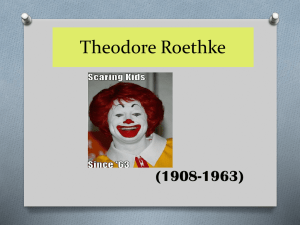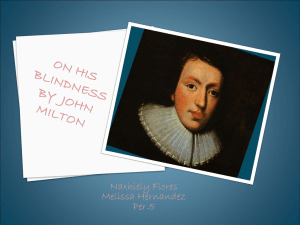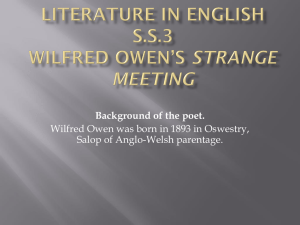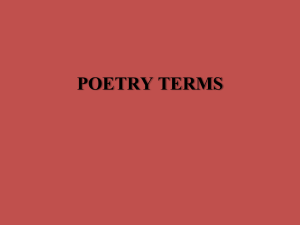The Poor 2A
advertisement
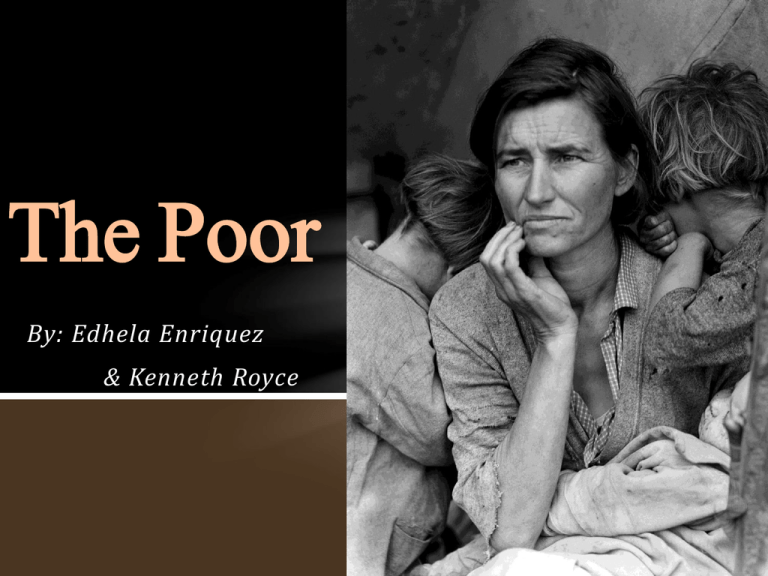
The Poor By: Edhela Enriquez & Kenneth Royce THESIS William contrasts the past & present of the neighborhood to portray the changes in the structure of society and its shortcomings through time. OVERALL INTERPRETATION • Those in poverty are used to its conditions while society tries to hide what is wrong and ignore what will eventually overwhelm them by trying to remain in control through false definition of what it really is that the poor needs • “It fits/the dress of children/reflecting every stage and/custom of necessity “ (7-10) • Shows contrast between past and present of how the neighborhood has changed: • “…the old/yellow wooden house indented/among the new brick tenements” (3-4) SENSES: Meaning and Language Purpose/Effect: Williams uses sarcasm in the beginning of the poem to show his feelings for how society tries to hide or ignore problems such as poverty, effectively showing the feeling contentment and justice in how poverty eventually “has overwhelmed the entire city” in the end of the poem. Speaker: Person who is pondering the irony about poverty Point of View: First person Mood: o Contentment “It’s the anarchy of poverty/delights me” (1-2) “in a wind that fitfully/turning his corner has/overwhelmed the entire city” (18-20) Tone: o Satire and sarcasm “It’s the anarchy of poverty/delights me” (1-2) Diction: o “anarchy” (1): uncontrollable chaos; an effort to put chaos in organized form o “delights” (2): satire or ridiculing of poverty and how it eventually overwhelmed the entire city SENSES: o “…the old/yellow wooden home indented/among the new brick tenements” (2-4) o “enclosing next to/nothing at all” (13-14) o “sweeps the sidewalk/his own ten feet of it” (16-17) Imagery and Symbols Purpose/Effect: The use of imagery portrays poverty for what it is and to emphasize how the setting has evolved from the old man’s house to the new buildings around it to show progression of time. Williams uses the symbols of what is thought to be necessary to compare society’s idea of what is needed to that of what the poor is used to thriving on, showing both sides of society. The symbolism for time portrays how the structure of society changed through time. Poverty imagery in poem: Time imagery in poem: o “…the old/yellow wooden home indented/among the new brick tenements” (2-4) o “Or a cast-iron balcony/with panels showing oak branches/in full leaf” (5-7) Symbolism: o “Chimneys, roofs, fences of/wood and metal” (11-12): what is necessary but is really not o “old man” (14): time – how he lived through the changes in society; poverty – he owns the old yellow house, from where the poverty started and spread STYLE: o “It’s the anarchy of poverty/delights me” (1-2): sarcastic ridiculing of how poverty is – to show human shortcomings Poetry Techniques Purpose/Effect: Williams uses juxtaposition to compare the old against the new to show time passing. He also juxtaposes the size of the old man’s property to the entire city to emphasize how much poverty has spread after a period of time. Satire Metaphor o “…It fits/the dress of the children” (7-8): metaphor of visual imagery – meant to show how the poor are used to the conditions they are living in Juxtaposition o “…the old/yellow wooden house indented/among the new brick tenements” (34): old vs. new o “children” & “old man” (8 & 14): to show difference between new generation and old generation o “his own ten feet” & “overwhelmed the entire city” (17 & 20): compares small size of old man’s property to the entire city to emphasize how much poverty spread Williams style of stream-ofconsciousness reflects his pondering on how structure of society has changed as time went on. Stream of consciousness throughout the poem STRUCTURE: Form, Organization, & Pattern Purpose/Effect: Williams uses enjambment to emphasize thought process of the speaker, in which the first sentence focuses more on the irony he finds about the growth of poverty throughout time, while the second sentence is more on his reflection on the life of someone in poverty and society’s part in ignoring the problem and allowing it to spread. End-stopped is used to show the breaks in the speakers almost continuous thought process, breaking it into parts: the beginning on portraying time passing; the middle on differences of what the poor and what society thinks is necessary to live; the ending on showing effects of time on the city. Enjambment o Only two sentences in the poem Lines 1-7 Lines 7-20 End-stopped o o o o “in full leaf.” (7) “custom of necessity – “ (10) “nothing at all:” (14) “hat who sweeps the sidewalk – “ (16) STRUCTURE: Form, Organization, & Pattern Purpose/Effect: By having four lines for all stanzas, it helps to reflect how time is constant and life goes on. Williams uses syllables to connect the first and last line with the idea that poverty is an uncontrollable chaos that has spread, and then the second line to show emphasis on the speaker’s feelings/thoughts on poverty, giving the poem a tone of satire or sarcasm. Stanzas o All stanzas have 4 lines Syllables o Most lines have 6-8 syllables, but three lines are different o Two lines have nine syllables: “It’s the anarchy of poverty” (1) “overwhelmed the entire city” (20) Both lines have nine syllables, connecting the two together with idea that poverty is uncontrollable chaos that eventually spread throughout the city o One line has five syllables: “delights me, the old” (2) Connects with the first line to emphasize the feeling/thoughts of the speaker on the concept of poverty SOUND: Musicality and Auditory Techniques Purpose/Effect: The poem is free verse with no rhyme in order to portray how there is no uniform perfection in society in relation to human shortcomings of poverty in the poem. By having pauses in poem not written in with commas or period, it coincides with the stream-of-consciousness style of the poem and how people really think when trying to understand the idea of the poor. Alliteration is used to emphasize the importance of the old man’s role in the poem as a symbol of time and poverty. Free verse o Entire poem Pauses in the poem not written in with commas or periods o Ending of poem no period – signify how there will always remain problems in society such as poverty Alliteration o Constant use of ”s” “in a sweater and soft black/hat who sweeps the sidewalk” (15-16) Connection to Other Poetry by Williams Poems with similar ideas: expresses humanity and its shortcomings o “The Eyeglasses” o “The Mind Hesitant” Use of imagery and enjambment to carry out what is trying to be expressed in poem Historical context: o Published in The Complete Collected Poems of William Carlos Williams, 1906-1938 (1938) Around time period of Great Depression and WWII o Williams lived around small towns with poverty and saw people struggle ACTIVITY: Discussion Questions What happens to the poem when the opening lines “It’s the anarchy of poverty/delights me” are removed from the poem? How would it affect the poem had Williams left it out? Would it change the interpretation and meaning of the poem? The speaker in the poem uses the word “delights” to describe poverty. Do you think it affects the tone or mood of the play? If you were to change that word, what would it be and why? (Consider how it will affect the tone of the poem.) Williams used the lines “in a wind that fitfully/turning his corner has/overwhelmed the entire city”. What do you think this “wind” is and what it represents? In the end of the poem, there is no punctuation at all. Considering the use of end-stopped throughout the poem, why do you think Williams did this? Do you think it represents something? CONCLUSION Based on how the poem ends, Williams portrays society’s shortcoming as it tries to hide and ignore what is wrong in society, which eventually overwhelmed them after time. Yet, society continues to try to remain in control of the chaos by defining what they think is necessary for the poor to thrive compared to what the poor are actually used to living on what they only know of.


